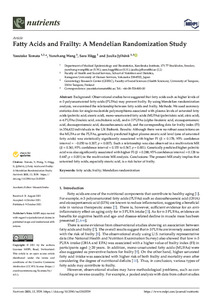Fatty acids and frailty : A mendelian randomization study
Tomata, Yasutake; Wang, Yunzhang; Hägg, Sara; Jylhävä, Juulia (2021-10)
Tomata, Yasutake
Wang, Yunzhang
Hägg, Sara
Jylhävä, Juulia
10 / 2021
3539
Julkaisun pysyvä osoite on
https://urn.fi/URN:NBN:fi:tuni-202110267833
https://urn.fi/URN:NBN:fi:tuni-202110267833
Kuvaus
Peer reviewed
Tiivistelmä
Background: Observational studies have suggested that fatty acids such as higher levels of n-3 polyunsaturated fatty acids (PUFAs) may prevent frailty. By using Mendelian randomization analysis, we examined the relationship between fatty acids and frailty. Methods: We used summary statistics data for single-nucleotide polymorphisms associated with plasma levels of saturated fatty acids (palmitic acid, stearic acid), mono-unsaturated fatty acids (MUFAs) (palmitoleic acid, oleic acid), n-6 PUFAs (linoleic acid, arachidonic acid), and n-3 PUFAs (alpha-linolenic acid, eicosapen-taenoic acid, docosapentaenoic acid, docosahexaenoic acid), and the corresponding data for frailty index (FI) in 356,432 individuals in the UK Biobank. Results: Although there were no robust associations on the MUFAs or the PUFAs, genetically predicted higher plasma stearic acid level (one of saturated fatty acids) was statistically significantly associated with higher FI (β = 0.178; 95% confidence interval = −0.050 to 0.307; p = 0.007). Such a relationship was also observed in a multivariate MR (β = 0.361; 95% confidence interval = 0.155 to 0.567; p = 0.001). Genetically predicted higher palmitic acid was also significantly associated with higher FI (β = 0.288; 95% confidence interval = 0.128 to 0.447; p < 0.001) in the multivariate MR analysis. Conclusions: The present MR study implies that saturated fatty acids, especially stearic acid, is a risk factor of frailty.
Kokoelmat
- TUNICRIS-julkaisut [16983]
